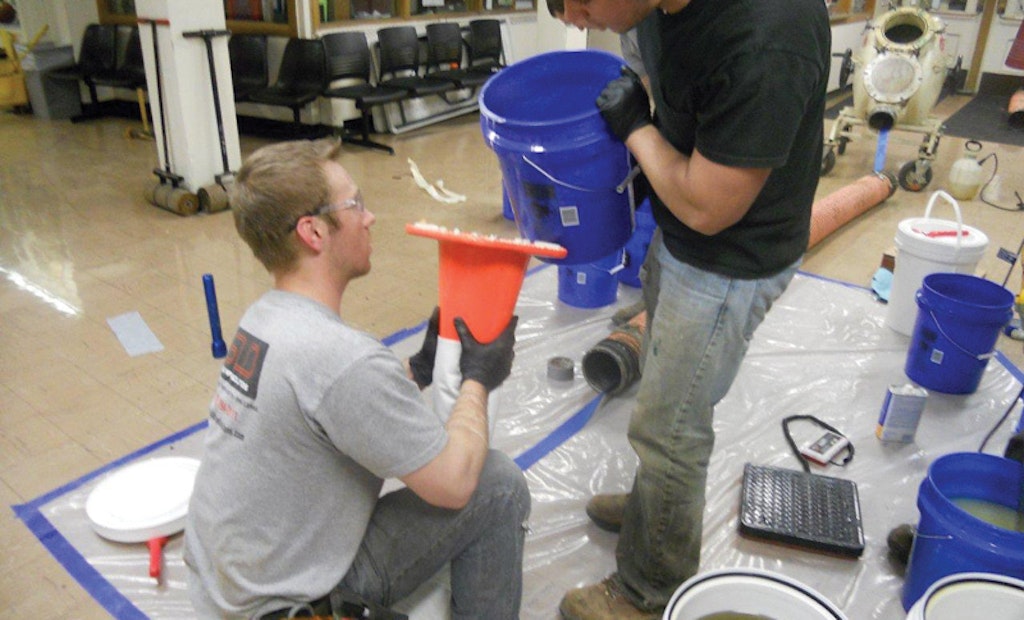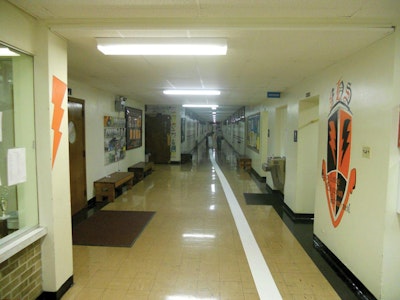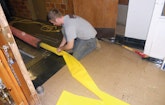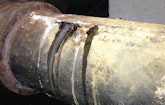
Interested in Cleaning?
Get Cleaning articles, news and videos right in your inbox! Sign up now.
Cleaning + Get AlertsStrong sewer odors permeating Franklin (Ill.) High School triggered complaints to Maintenance Superintendent Darrin Seymour. He knew the problem stemmed from cracks in a 6-inch ductile iron main. The 205-foot-long pipe hung in a utility corridor beneath the main hallway, but most of the line was under 4 feet of backfill. Searching for rehabilitation options on the Internet led Seymour to SLB Pipe Solutions in Bedford, Ind.
“The situation was bad,” says SLB co-owner Eric Spreen. “We pushed our RIDGID SeeSnake upstream through the 6-inch cleanout in the boiler room, but couldn’t see much. The line was so occluded that forward progress stopped at 100 feet and we had to guess at the rest.”
Working after hours, Spreen’s team used cured-in-place pipe from Perma-Liner Industries to successfully rehabilitate the oldest main in the original section of the school.
Classic curriculum
Seymour hired Rooter-Man/Sani Systems in Modesto, Ill., to clean the line. Technician Dave Buhl used a trailer-mounted O’Brien 3515 sewer jetter with 400 feet of 3/4-inch hose, a 15 gpm/3,500 psi pump and two AquaNOZ nozzles from Arthur Products Co.
Beginning at the manhole in the parking lot, Buhl jetted upstream at 2,500 psi using one nozzle with forward and rear orifices and another with just rear jets. At 50 feet, Buhl hit a straight tee leading to the boiler room cleanout. After moving the jetter to the service door, Seymour and the SLB crew helped pull the hose inside and guide it around corners to the cleanout.
“It was the middle of December, so I was very happy to come in out of the cold,” says Buhl. “The pipe had so much debris that it took seven hours to clean 152 feet upstream from the cleanout. The effort plumb wore me out.”
Meanwhile, Spreen’s crew brought in the lining components and covered the main corridor’s floor with plastic. The four of them made a dry run carrying the inversion unit down two flights of stairs and rolling it 100 feet into the boiler room.
“That familiarized us with how we had to negotiate the stairs and not lose control of the unit, which weighed 200 pounds less without the liner,” says Spreen. “Once we began mixing resins, we had 45 minutes working time.”
When Buhl finished at 11 p.m., the team laid out the 102-foot liner and impregnated it with hot resin using 100-pound laminate floor rollers. The labor-intensive trip to the boiler room went smoothly. “We shot the liner in three minutes at 10 to 12 psi,” says Spreen. “Then we shot the calibration tube through the liner, monitored the gauges for 90 minutes to make sure pressure held at 13 psi, and went to the hotel.”
Additional homework
Saturday morning, the crew returned to remove the calibration tube and inspect the liner. Once Seymour saw how well it had rehabilitated the sewer, he added the remaining 103 feet to the contract. Spreen didn’t have enough material for the second shot and had to return a few days later.
That Sunday, Buhl set up in the boiler room and cleaned 25 feet before hitting an obstruction. “We fought the situation for a while, but the pipe was too encrusted for the hose to pass through it,” he says.
Spreen suggested sending down the camera head to pull back the jetter. To access the junction of the old sewer main with the new, Seymour sawed a 2- by 2-foot hole in the concrete floor. “We hand-dug 4 feet down through backfill to the joint, then opened the pipe downstream of it,” says Spreen.
The camera revealed a run of 25 feet, then a sweeping 90-degree turn to the right followed by a 53-foot straight stretch and a sweeping 90-degree turn to the left. “We just managed to wiggle through the turn, so that had to be our trouble spot,” Spreen says.
The pipe ran straight for 25 feet before entering the lined section. When the camera head emerged from the cleanout, Buhl attached his hose with zip ties and duct tape, then Spreen pulled it back and untied the hose.
“I started jetting and pulling back debris,” says Buhl. “A rat carcass was in there and multiple cafeteria items. At least a quarter of the invert was full, enough material to plug the sewer from the cleanout to the manhole. I have never pulled that much material out of a pipe before.” The work took five hours.
Pass with flying colors
With Buhl cleaning upstream from the manhole again, Spreen’s crew wetted out the liner and lubricated it with vegetable oil to facilitate its trip through the bends. They dropped the inversion hose through the access hole into the sewer, and increased pressure to 15 pounds as the liner entered the bends. When inverted, the liner overlapped the first liner by three feet.
Leaving the liner to cure overnight, the team returned the next morning to reinstate two 3-inch floor drains and three 4-inch laterals. Seymour guided them to the proper locations in the 4-foot-wide utility corridor. A short length of the downstream main was exposed, enabling workers to see resin oozing from lined 12-inch-long cracks.
Most of the corridor was impassable, filled with sprinkler lines, telecommunication cables, power lines, and heating and ventilation pipes hanging from the ceiling. “All we could do was army crawl over the backfill,” says Spreen. “We had about 3 feet of headroom.”
The only tool that fit into the reinstatement spaces was a flexible shaft powered by an electric Dremel 4000 rotary hand piece (Robert Bosch). “Hobbyists use them,” says Spreen. “Consequently, we wore out a lot of cut-off wheels. It was miserable work because we were in cramped positions and hot, sweaty and dirty.”
Reinstating the connections took two hours, then the crew joined them to the main with PVC pipe and Fernco PVC couplings. When teachers and students returned from Christmas break, the school was free of sewer odors.








